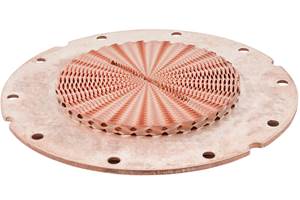Additive Manufacturing Media Launches New Podcast: AM Radio
Podcast will cover how additive is changing manufacturing and showcases the incredible work that goes on inside 3D printing facilities.

“AM Radio” is focused on providing insights into what makes additive technology what it is today in a way that manufacturers and additive experts alike can enjoy.
Additive Manufacturing is launching a new, ongoing podcast, “AM Radio” this month. The podcast tackles the biggest topics in additive manufacturing (AM), such as challenges to adopting AM, technology innovations and how 3D printing is advancing manufacturing. With a front row seat, listeners learn about the latest advances within the AM space from a variety of technology suppliers, end-users and intriguing new startups.
“AM Radio” is hosted by AM’s Editor-in-Chief Peter Zelinski and Senior Editor Stephanie Hendrixson — who also host AM’s popular video series The Cool Parts Show. Joining them will be Additive Manufacturing’s newest editor, Julia Hider.
The first episode sheds light on where 3D printing lies in the manufacturing space and how it stands out among other production methods, driving startups and small businesses. New episodes will be released every other Monday.

AM Radio will be hosted by AM Senior Editor Stephanie Hendrixson, Associate Editor Julia Hider and Editor-in-Chief Peter Zelinski.
In later episodes, Zelinski, Hendrixson and Hider will dive into topics such as companies building their own 3D printers, sustainability in AM and the reasons behind staying optimistic about AM in today’s world. The hosts will step foot into the facilities where additive happens and share their latest findings.
“We have access to the companies and people who are succeeding with additive’s latest technology or who soon will be,” notes Hendrixson. “We visit their facilities, see their work and talk with them about the challenges and promises of additive manufacturing. AM Radio will be an outlet for us to share more of what we witness, as well as provide context and analysis for those observations.”
The AM podcast is designed to be different from other industry podcasts. It brings together the AM editors’ expertise from their travels and reporting, sharing what they’ve learned primarily from AM users — the lessons they are coming to that others in their audience could learn from, as well as the trends they see playing out across various industry sectors.
“The podcast complements our existing print magazine, website, video and social media channels as a space where we can tackle big ideas in additive, explore emerging trends and let our audience in on the story behind the story,” Hendrixson says. “Our goal is to tune into what’s really happening in additive manufacturing, and help listeners understand what it might mean for their businesses and industries.”
“AM Radio” is focused on providing insights into what makes additive technology what it is today in a way that manufacturers and additive experts alike can enjoy. Along the way, the AM team plans to bring in guest hosts from their Gardner Business Media sister publications for invaluable insights into how AM is changing the manufacturing landscape across a gamut of industries.
Listeners can find “AM Radio” on Apple Podcasts, Spotify and all major podcast platforms. Learn more and find links to subscribe at gbm.media/amradio.
Related Content
Video: 5" Diameter Navy Artillery Rounds Made Through Robot Directed Energy Deposition (DED) Instead of Forging
Big Metal Additive conceives additive manufacturing production factory making hundreds of Navy projectile housings per day.
Read More3D Printed Titanium Replaces Aluminum for Unmanned Aircraft Wing Splice: The Cool Parts Show #72
Rapid Plasma Deposition produces the near-net-shape preform for a newly designed wing splice for remotely piloted aircraft from General Atomics. The Cool Parts Show visits Norsk Titanium, where this part is made.
Read MoreWith Electrochemical Additive Manufacturing (ECAM), Cooling Technology Is Advancing by Degrees
San Diego-based Fabric8Labs is applying electroplating chemistries and DLP-style machines to 3D print cold plates for the semiconductor industry in pure copper. These complex geometries combined with the rise of liquid cooling systems promise significant improvements for thermal management.
Read MoreBeehive Industries Is Going Big on Small-Scale Engines Made Through Additive Manufacturing
Backed by decades of experience in both aviation and additive, the company is now laser-focused on a single goal: developing, proving and scaling production of engines providing 5,000 lbs of thrust or less.
Read MoreRead Next
Crushable Lattices: The Lightweight Structures That Will Protect an Interplanetary Payload
NASA uses laser powder bed fusion plus chemical etching to create the lattice forms engineered to keep Mars rocks safe during a crash landing on Earth.
Read MorePostprocessing Steps and Costs for Metal 3D Printing
When your metal part is done 3D printing, you just pull it out of the machine and start using it, right? Not exactly.
Read MoreBike Manufacturer Uses Additive Manufacturing to Create Lighter, More Complex, Customized Parts
Titanium bike frame manufacturer Hanglun Technology mixes precision casting with 3D printing to create bikes that offer increased speed and reduced turbulence during long-distance rides, offering a smoother, faster and more efficient cycling experience.
Read More



















